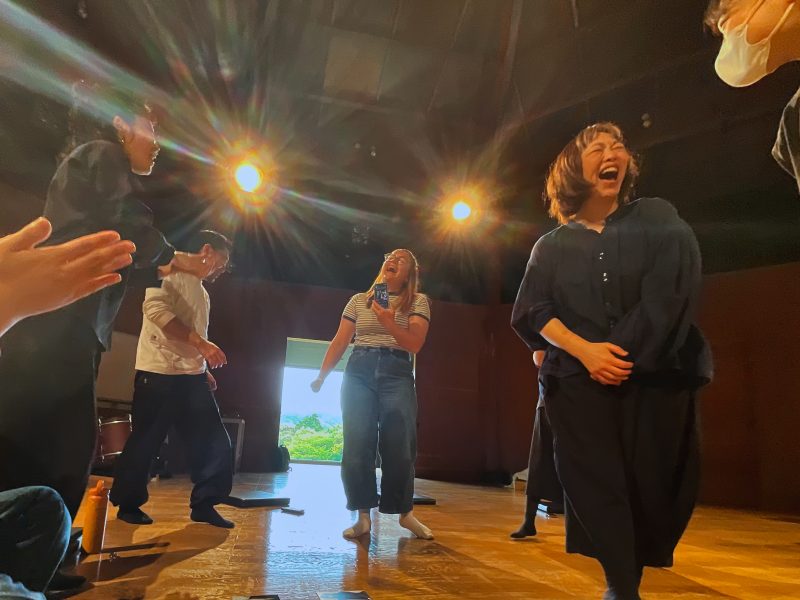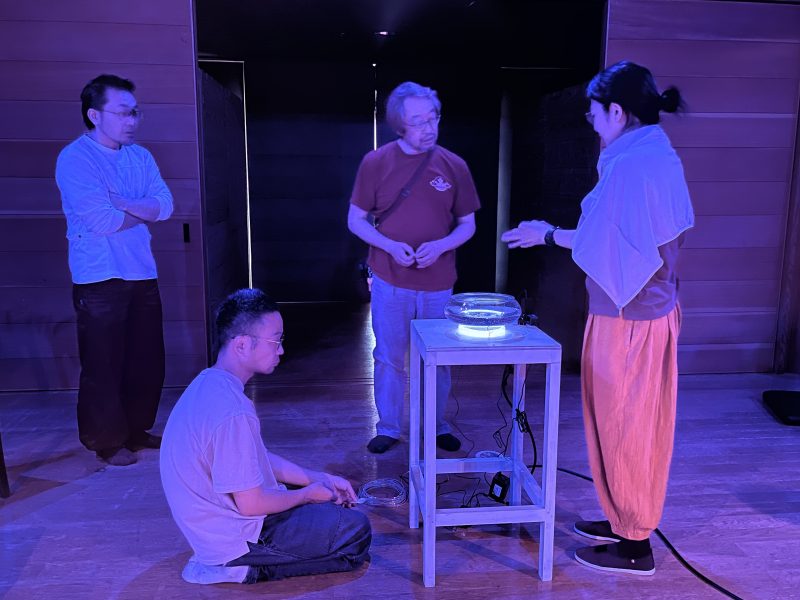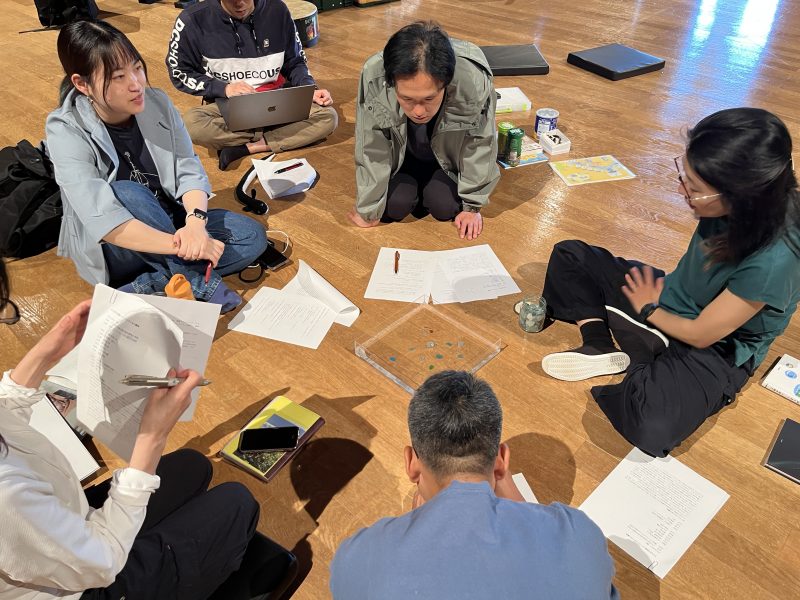ウナギはどこで生まれるか、ご存じですか?
ウナギは日本の沿岸から何千キロも離れた海で卵を産み、命を終えます。
孵化した稚魚は長い旅を経て、日本の淡水域へと戻ってきます。
SPAC-静岡県舞台芸術センターの新たなプロジェクトでは、劇作家・石神夏希さんのもと、SPACの俳優と静岡に住むブラジルにルーツを持つ出演者たちが、この不思議な魚の旅をモチーフに演劇を通じて新たな物語を紡いでいます。
〜演劇は、自分が生まれるよりもずっと前に始まった物語を引き継ぐ、唯一の方法だ〜
◼️自己紹介
こんにちは、私はエレーヌです。
フランスで5年ほどフランス国立の劇場でのスタッフとして経験を積んだ後、「自分を自由にする」ため、日本へやってきました。
SPACの皆さんに迎え入れていただき、石神夏希さんが演出され2026年春に初演を予定している『うなぎの回遊』(仮題)の 創作初期に立ち会うという、かけがえのない2週間を過ごしています。
◼️プロジェクトに参加して
一ヶ月ほど日本全国を旅したのち、私は静岡市・日本平の丘にある静岡県舞台芸術公園にしばらく滞在することになりました。東京ドーム約4つ分の広大な敷地には、劇場、稽古場、宿泊施設、オフィス、そして茶畑が広がり、自然と創造の時間が静かに流れています。
今回のプロジェクトにインターンとして合流できることに胸を躍らせながら、私は園内にある「稽古場棟」へと向かいました。SPACは約40名の俳優が所属しており、国内外で評価されているユニークな公共劇場・劇団です。
私の日本語力はまだ初級レベルで、不安もありましたが、現場で迎えてくれた皆さんのあたたかい笑顔に救われました。言葉を超えて心でつながる感覚を強く感じた瞬間でした。
◼️オープン・スタジオまでの8日間
このプロジェクトには、SPACの俳優と、静岡に住むブラジルにルーツを持つ出演者の両方が参加します。県民出演者は後日合流予定(4月27日)で、執筆をしている4月25日現在はSPACに所属する俳優、スタッフ、インターン生の約10名のチームで活動していて、4月29日、5月5日に開催する「オープン・スタジオ」に向けて創作を進めています。
このオープン・スタジオは、一般非公開、主に演劇関係者に向けて行われる発表の場で、数日間にわたる稽古の成果と、この作品のコンセプトを共有するものです。石神さんはこのオープン・スタジオを「これから私たちが共に向かう旅の本質と行き先を共有する機会」と語っています。
この4月から5月にかけての2週間は、SPAC所属のチームとブラジルにルーツを持つ県民の皆さんが深い関係性を築き、共に創る、新しい出会いと経験の始まりとなります。

オープン・スタジオに向けて園内各所でクリエーションをするSPAC俳優・スタッフ
◼️チームワークの強さ
深い関係性という話でいえば、稽古場には芸術を通じた確かなつながりに満ちています。
私たちは毎日、稽古のはじめに「チェックイン」という時間を設けていて、俳優、スタッフのすべてのメンバーが、自分自身の体験をひとつ共有します。
それは、子どものころの思い出だったり、日常のエピソードだったり、ちょっとした雑談や、時にはとても個人的な告白だったりもします。この思いやりに満ちた、安全で思索的な空間のなかで、私は安心して自分の気持ちを伝えることができています。英語で、SPAC制作スタッフの坂中季樹(さかなか としき)さんに通訳してもらいながら、たとえば「イースターをすっかり忘れていたことに気づいて寂しくなった」とか、「丘の上の暗い公園で、野生動物に出会うかもしれないと感じた夜の不安」など、その日の感情を素直に話すことができました。
この毎日のチェック・インは、誰もが大切にされ、耳を傾けてもらえているという実感を与えてくれます。
誰もが自分のスキルだけでなく「その人らしさ」そのものを通して創作に貢献していて、それがこのコラボレーションを力強いものにしているのだと感じます。その関係性は、作品そのものにも自然と滲み出ていきます。

チェック・インを通じて打ち解けるSPACメンバーと私
SPACの現場では、肩書きを超えてあらゆる人が創作に関わります。
たとえば、海の深さを表現するために「生命の循環」を象徴するシーグラス(波に揉まれて角が取れ、海に流れ着いたガラスゴミが、年月をかけて変化したガラス片)に光を当てる方法を考える場面では、俳優も技術スタッフも一体となって試行錯誤を重ねていました。

照明効果について試行錯誤する俳優とスタッフ
また、屋外シーンでは、まだ到着していない出演者の代役をスタッフが自然に務めたり、アイデアを出し合ったりと、皆が率先して動く姿が印象的でした。
この現場では「チームワーク」という言葉が本当の意味で息づいていて、誰もが創作に参加し、支え合い、ひとつの舞台を共に築き上げています。

俳優・スタッフで打ち合わせを重ねる日々
そんななか、私は気がつけばプロジェクトの「パーカッション担当」にもなっていました。この話は、また次回。
ENGLISH
FOLLOWING UP “EEL MIGRATION (TBA)”
〜Part I: The strength of teamwork〜
Have you ever wondered where eels are born?
Eels lay their eggs thousands of miles from the Japanese coast, and die once it pours out its seed.
Once the baby eel is out of its shell, it travels back to Japan to live in the country’s fresh waters.
In this new project by the Shizuoka Performing Arts Center, director Natsuki Ishigami brings together actors from SPAC and non-professional actors with roots in Brazil who live in Shizuoka prefecture, with the concept inspired by journey of these fascinating 100-million-year-old fish.
“Theatre is the only way to take up a story that someone else started long before I was born.”
◼️Who am I?
My name is Hélène, and after almost five years’ experience in theatre and national stages in France, I’ve come to Japan to lose myself.
Welcomed by the SPAC teams for a fortnight, I had the chance to follow the setting up of the Open Studio of the Eel Project, a SPAC creation scheduled for Spring 2026, directed by Natsuki Ishigami.
◼️Joining temporarily the Eel Project
After a month travelling across Japan with my backpack, I’m temporarily settling down on Nihondaira Hill in Shizuoka City, in the heart of the Shizuoka Performing Arts Park.
Founded in 1995, this immense green setting, about four times as big as Tokyo Dome, contains several performance halls, offices, accommodations, rehearsal rooms, and tea plantations to encircle it all.
Today I have an appointment at the rehearsal hall, a venue perfectly integrated into the hills landscape.
When I get there, I can’t wait to meet the team behind the Eel Project(The title of the project is “Eel Migration”, but since the title of this porject is still tentative, we usually refer to it internally as the “Eel Project”. ), and to immerse myself in the making process of a SPAC show: this Japanese institution, directed by Satoshi Miyagi since 2007, is internationally renowned for its creations as well as for the uniqueness of its functioning, as SPAC is a home to around 40 actors
Despite the excitement, I was still a little nervous, as my level in Japanese was very basic, and this production is deeply rooted in the history and territory of Shizuoka, mainly performed by locals.
Luckily for me, all my stress was relieved when I saw how I was welcomed by the team, with warm smiles and faces.
Even though I don’t speak the language they speak, I feel that I will still be able to communicate as they communicate with each other beyond words.
Every member of the team gives me an encouraging and reassuring smile: I can feel that the next two weeks are going to be very unique.
◼️Eight days to prepare the Open Studio
Eel project is made up of two types of performers: professional actors employed by SPAC, and non-professional actors from Shizuoka.
While the local participants will be arriving in a few days, there are currently ten of us working together to set up the Open Studio, which will be held in eight days.
This event, open only to a selected audience, will be a performance born of the various workshops and rehearsals carried out over the next few days by the whole team at the Shizuoka Performing Arts Park.
This will give them “the opportunity to share the essence and destination of the project we are going to carry out together,” says director Natsuki Ishigami on the SPAC blog.
These two weeks in April to May, 2025 and the Open Studio will therefore be the beginnings of an artistic and human experience, conducted in harmonious communion between SPAC’s artistic team and Hamamatsu’s residents, from the province of Shizuoka.
“Despite the time constraints and the distance,” she continues, “we are embarking on a year-long journey that will enable us to create deep relationships with each other.”
◼️The strength of teamwork
Speaking of deep relationships, there is no doubt that the rehearsal room is full of artistic connections. At the start of each day’s work, the director invites everyone to share their state of mind, through a deep or fleeting thought, or a perspective on life or on the project. In this safe space, full of kindness and thoughtful human beings, I feel perfectly at ease to share—in English, with the help of my translator and circle neighbor, Toshiki Sakanaka, a production staff of SPAC—my feelings of the day: the emotion I felt when I realized by chance that I was missing the Easter celebrations, or my fear of an attack by wild animals in the heart of this park perched at the top of the hill on my first night.
SPAC actors and staff engaging in creation across various areas of the park in preparation for the Open Studio
Each member in the circle—composer, actors, actresses, sound designer, set designer—shares something of their own experience, whether a childhood memory or an everyday life episode, a casual fact or an intimate confession.
This ritual makes each of us feel valued and heard: it helps build trust between us, supports and understands each other, and it really shows in the artistic work. In fact, every individual in the circle, with their skills and personality, contributes in their own way to the success of the show.
Even though the work process is nourished by everyone’s skills and singularity, all the Eel project’s members also easily outgrown their function to participate in the creative process. I realized this even on my first day at work. I was amazed by how naturally and easily everyone is making suggestions, getting involved, and trying things out in all aspects of the performance.
To illuminate the space, for example, In order to sink the audience into the deep ocean, we had to find a way of highlighting the sea glass which embodies the circling nature of life.
Actors, designers, and members of the production team kept coming up with suggestions and solutions to achieve the desired effect, either by searching for ideas on the internet or by manipulating objects.
Their intuitive reaction amazed me, as solving this problem had now become a collective challenge.
Similarly, part of the performance will take place outdoors, and will be voiced by the non-professional performers who have not arrived yet.
For staging these scenes, the members of the production team gave cues, adapted to the director’s comments, and suggested ideas.
They climbed onto the roof, grabbed the megaphone, and read lines in place of the future performers—no one needed to be asked; they naturally proposed potential solutions.
What struck me most during these first few days is how well they know and trust each other, and how this team of talented individuals relies on each other’s vision to create a collective spirit that goes beyond their assigned roles and professional skills.
Here, the expression “teamwork” takes on its full meaning: collaboration is fluid, and everyone participates because everyone has something to bring to the group.
That’s how I ended up as a percussionist on the project—but I’ll tell you more about that soon.
FRENCH
SUR LA ROUTE DU EEL MIGRATION (Titre provisoire),
Partie 1 : La force du collectif
Vous êtes-vous déjà demandés où naissent les anguilles ?
Les anguilles pondent à des milliers de kilomètres des côtes japonaises, et décèdent une fois leur semence déversée. Leurs petits, une fois sortis de leur coquille, font le trajet inverse pour revenir vivre dans les eaux du Japon.
Dans ce nouveau projet du Shizuoka Performing Arts Center, la metteuse en scène Natsuki Ishigami réunit comédiens du SPAC et comédiens non-professionnels, ayant une attache avec le Brésil et vivant dans la préfecture de Shizuoka, dans un projet inspiré par le fascinant voyage de ces poissons symboliques, vieux de 100 millions d’années.
“Le Théâtre est la seule manière de reprendre une histoire que quelqu’un d’autre a commencée bien avant ma naissance”
Qui suis-je ?
Je m’appelle Hélène, et après presque cinq ans d’expériences en théâtre et scènes nationales en France, je suis venue me perdre au Japon. Recueillie par les équipes du SPAC pendant deux semaines, j’ai eu la chance de suivre la mise en place de l’Open Studio du projet Eel migration, création du SPAC prévue au Printemps 2026, dirigé par Natsuki Ishigami.
Intégrée temporairement le projet d’Eel migration
Après un mois à traverser le Japon avec mon sac à dos, je pose temporairement mes valises sur la colline de Nihondaira, à Shizuoka City, au cœur du Shizuoka Performing Arts Park. Fondé en 1995, cet immense écrin de verdure dont la superficie représente près de quatre fois celle du Tokyo Dôme contient plusieurs salles de représentation, des bureaux, des logements, des salles de répétition et des plantations de thé pour encercler le tout. Aujourd’hui, j’ai rendez-vous dans une salle de répétition qui s’intègre parfaitement dans les collines du paysage.
En arrivant sur place, je suis impatiente de rencontrer l’équipe qui porte le projet Eel Migration, ainsi que de m’immerger dans le processus de fabrication d’une production du SPAC : cette institution japonaise, dirigée par Satoshi Miyagi depuis 2007, est renommée internationalement pour ses créations comme pour la singularité de son équipe composé d’une quarantaine de comédiens.
Malgré l’excitation, je suis nerveuse car mon niveau de japonais reste élémentaire, et cette création, enracinée dans l’histoire et le territoire de Shizuoka, est portée exclusivement par des comédiens du SPAC et des locaux. Bien heureusement pour moi, tout le stress est retombé en constatant le chaleureux accueil que m’a offert toute l’équipe. Je ne parle pas la langue avec laquelle ils discutent, mais dans leur manière d’échanger et de communiquer avec moi, je parviens à comprendre les intentions, la teneur des échanges. Chaque membre m’adresse des sourires chaleureux : je sens que les deux prochaines semaines vont être passionnantes.
Huit jours pour préparer l’Open Studio
Le projet Eel migration est composé de deux groupes d’interprètes : des comédiens professionnels salariés du SPAC, et des comédiens non-professionnels originaires de la préfecture de Shizuoka.
Tandis que les participants amateurs arrivent quelques jours plus tard, nous sommes pour le moment dix à nous retrouver pour mettre en place l’Open Studio qui se tiendra dans huit jours. Cet événement, ouvert uniquement à un public restreint, prendra la forme d’une performance née des différents ateliers et répétitions menés au Shizuoka Performing Arts Park ces prochains jours par l’ensemble de l’équipe. Ce moment va leur permettre d’avoir “l’opportunité de partager l’essence et la destination du projet que nous allons mener ensemble”, affirme la metteur en scène Natsuki Ishigami sur le blog du SPAC.
Ces deux semaines d’avril 2025 et l’Open Studio qui viendra les conclure seront donc le prémices d’une expérience artistique et humaine, menée en communion entre les équipes artistiques du SPAC et les participants amateurs. “Malgré la contrainte de temps et la distance,” continue t-elle, “nous embarquons pour un voyage d’un an qui va nous permettre de créer des relations profondes les uns avec les autres.”
La force du collectif
Dès les premiers instants, il ne fait aucun doute que les relations entre les uns et les autres sont la clef de voûte de la démarche artistique. Commençant chaque journée de travail par un tour de table, la metteuse en scène invite chacun à partager son état d’esprit, une pensée, profonde ou fugace, une réflexion, sur le projet ou l’existence en général. Dans cet espace de confiance, je me sens parfaitement à l’aise pour partager – en anglais, avec l’aide de mon traducteur et voisin de cercle, Toshiki Sakanaka, salarié du SPAC – mon ressenti du jour : l’émotion que j’ai ressenti quand j’ai réalisé par hasard que je ratais les fêtes de Pâques, ou de ma crainte la première nuit d’une attaque de bêtes sauvages au coeur de ce parc encerclé par une nature abondante.
Chaque membre du cercle, compositrice, acteurs, actrices, designer sonore, scénographe, partage quelque chose de son vécu, immédiat ou lointain, intime ou anecdotique. Par ce rituel, chaque individu se sent alors entendu, valorisé comme faisant partie d’un tout : cela appuie ce sentiment qu’ici, la réussite du collectif dépend des compétences et individualités de chacun.
Et cette dynamique, je la retrouve dès mon premier jour de travail. Bien que chaque membre de l’équipe se soit présenté avec une fonction, celle-ci devient secondaire une fois dans la création artistique où chacun s’investit, suggère des idées, propose des pistes de réflexion.
Pour la mise en lumière de l’espace, par exemple, il nous faut trouver un moyen de mettre en lumière le verre pilé, objet aux teintes océaniques qui témoigne de la circularité de l’existence. Acteurs, comédiens, membres de l’équipe de production enchaînent les suggestions et les solutions pour parvenir à l’effet voulu.
De la même manière, la partie extérieure de la performance sera mise en voix par les interprètes amateurs, encore absents des répétitions ces premiers jours. Pour la mise en espace, les membres de l’équipe de production donnent la réplique, s’adaptent aux commentaires de la metteuse en scène. Montant sur le toit, prenant le mégaphone, lisant les répliques à la place des futurs interprètes, nul besoin de leur demander pour qu’ils soient force de proposition.
Travaillant ensemble depuis des années, les équipes du SPAC se connaissent bien et s’inspirent des talents des uns et des autres pour créer un véritable esprit collectif qui dépasse les rôles assignés dans une création théâtrale.
Les journées de répétition font l’objet d’échange continu entre les comédiens et l’équipe
J’ai l’impression qu’ici, l’expression “travail d’équipe” prend tout son sens, que la collaboration est parfaitement fluide : c’est d’ailleurs comme ça que je me suis retrouvée percussionniste sur le projet, mais ça, je vous le raconterai bientôt.